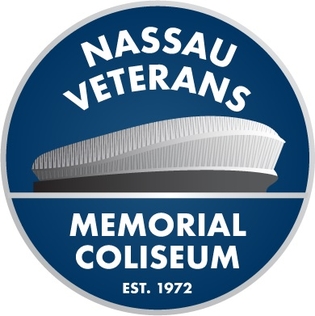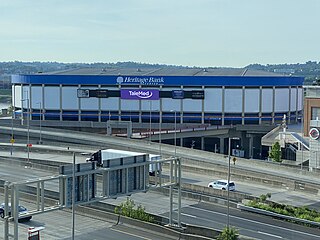
Nassau Veterans Memorial Coliseum is a multi-purpose indoor arena in Uniondale, New York, east of New York City. The Long Island venue is approximately 7 miles (11 km) east of the eastern limits of the New York City Borough of Queens, and is also next to the Meadowbrook Parkway.

Oakland Arena is an indoor arena located in Oakland, California, United States. From its opening in 1966 until 1996, it was known as the Oakland–Alameda County Coliseum Arena. After a major renovation completed in 1997, the arena was renamed The Arena in Oakland until 2005 and Oracle Arena from 2006 to 2019. It is often referred to as the Oakland Coliseum Arena as it is part of the Oakland–Alameda County Coliseum Complex with the adjacent Oakland Coliseum. Oakland Arena seats 19,596 fans for basketball.

Northlands Coliseum is a defunct indoor arena in Edmonton, Alberta, on the north side of Northlands. It was used for sports events and concerts, and was home to the Edmonton Oilers of the World Hockey Association (WHA) and National Hockey League (NHL), and the Edmonton Oil Kings of the Western Hockey League (WHL). The arena opened in 1974, and was later known as Edmonton Coliseum, Skyreach Centre, and Rexall Place, before returning to the Northlands Coliseum name in summer 2016.

Cincinnati Gardens was an indoor arena located in Cincinnati, Ohio, that opened in 1949. The 25,000 square foot brick and limestone building at 2250 Seymour Avenue in Bond Hill had an entrance that was decorated with six three-dimensional carved athletic figures. When it opened, its seating capacity of 11,000+ made it the seventh largest indoor arena in the United States.

Chicago Coliseum was the name applied to three large indoor arenas, which stood at various times in Chicago, Illinois, from the 1860s to 1982. They served as venues for large national conventions, exhibition halls, sports events, and entertainment.

Colisée de Québec is a defunct multi-purpose arena located in Quebec City, Quebec. It was the home of the Quebec Nordiques from 1972 to 1995, during their time in the World Hockey Association and National Hockey League. It was also the home of the Quebec Remparts of the Quebec Major Junior Hockey League from 1999 until its closing in 2015. The Colisée hosted the Quebec International Pee-Wee Hockey Tournament each February until its closure in 2015, with almost 2,300 young hockey players from 16 countries participating annually.

Pacific Coliseum, known to locals as "The Coliseum" or the "Rink on Renfrew," is an indoor arena located at Hastings Park in Vancouver, British Columbia. Its main use has been for ice hockey and the arena has been the home for several ice hockey teams.

Heritage Bank Center is an indoor arena located in downtown Cincinnati, next to the Great American Ball Park. It was completed in September 1975 and named Riverfront Coliseum because of its placement next to Riverfront Stadium. In 1997, the facility became known as The Crown, and in 1999, it changed its name again to Firstar Center after Firstar Bank assumed naming rights. In 2002, following Firstar's merger with U.S. Bank, the arena took on the name U.S. Bank Arena and kept that name until 2019.

Arizona Veterans Memorial Coliseum is a 14,870-seat multi-purpose indoor arena in Phoenix, Arizona, United States, located at the Arizona State Fairgrounds. It hosted the Phoenix Suns of the National Basketball Association from 1968 to 1992, as well as indoor soccer, roller derby and major and minor league ice hockey teams.

Bojangles Coliseum is an 8,600-seat multi-purpose arena located in Charlotte, North Carolina. It is operated by the Charlotte Regional Visitors Authority, which also oversees nearby Ovens Auditorium and the uptown Charlotte Convention Center. The naming-rights sponsor is the Bojangles restaurant chain. The building's signature domed roof is made of tin, rather than steel or iron. The dome spans 332 feet in diameter and rises to 112 feet tall.

The Indiana Farmers Coliseum is a 6,500-seat indoor multi-use arena, located on the Indiana State Fairgrounds in Indianapolis. The Indiana Farmers Coliseum is home to both the Indy Fuel of the ECHL and the IUPUI Jaguars of the NCAA.
Lance Russell was an American sports broadcaster and ring announcer, primarily serving as a professional wrestling announcer and commentator in the Memphis region from 1959 to 1997. In NWA Mid-America and its descendant, the Continental Wrestling Association Russell's primary announcing partner was Dave Brown. He is included in the National Wrestling Alliance (NWA)'s Hall of Fame and Hall of Heroes. In addition, he is in the United States Wrestling Association (USWA)'s Memphis Wrestling Hall of Fame and Wrestling Observer Newsletter's Hall of Fame.

Sam Houston Coliseum was an indoor arena located in Houston, Texas.

J. S. Dorton Arena is a 7,610-seat multi-purpose arena located in Raleigh, North Carolina, on the grounds of the North Carolina State Fair. It opened in 1952.

The Uline Arena, later renamed the Washington Coliseum, was an indoor arena in Washington, D.C. located at 1132, 1140, and 1146 3rd Street, Northeast, Washington, D.C. It was the site of one of President Dwight D. Eisenhower's inaugural balls in 1953, the first concert by The Beatles in the United States in 1964, and several other memorable moments in sports, show business, politics and in the civil rights movement of the 1960s. It had a capacity of over 8,000 people and was a major event space in Washington until the early 1970s.

Bayfront Center was an indoor arena located in St. Petersburg, Florida that hosted many concerts, sporting and other events. Depending on the configuration, it could hold up to 8,600 people. The arena was opened in 1965 and demolished in 2004. It adjoined the Mahaffey Theater, which is still standing.

The Kay Bailey Hutchison Convention Center is a convention center in the Convention Center District of downtown Dallas, Texas.

Continental Wrestling Association was a wrestling promotion managed by Jerry Jarrett. The CWA was the name of the "governing body" for the Championship Wrestling, Inc. promotion which was usually referred to as Mid-Southern Wrestling or the Memphis territory. This promotion was a chief NWA territory during the 1970s and early 1980s while operating out of Tennessee and Kentucky. The CWA was a member of the National Wrestling Alliance until 1986 and affiliated with the American Wrestling Association until 1989. In 1989, the CWA merged with the World Class Wrestling Association to form the United States Wrestling Association thus ceasing to exist as a separate entity. Lance Russell and Dave Brown were the television commentators and hosts for the Memphis territory, including the Continental Wrestling Association.

Jonathan Barry Boyle was an Australian professional wrestler, better known by the ring name "Lord" Jonathan Boyd. Initially Boyd competed both in North American and international promotions as part of the Royal Kangaroos with his cousin Norman Frederick Charles III. Later on Boyd would team up with Luke Williams as the Sheepherders and compete in many North American federations such as the Continental Wrestling Association, Southeast Championship Wrestling, and Southwest Championship Wrestling. Boyd would also act as a manager for Luke and Butch Miller as they competed under the "Sheepherder" name.
The 1979–80 season was the North American Soccer League's first ever full indoor soccer season with playoffs. It began in November 1979, and the championship occurred in March 1980.




















